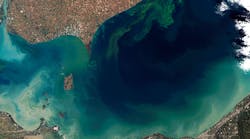Threat to Drinking Water of 400,000 in Ohio Linked to Chemical Runoff from Fertilizers
Residents of Toledo, Ohio, woke up to a sobering warning on August 2: Don’t drink the water. Chemists testing water at Toledo’s Collins Park Water Treatment Plant had two sample readings for microcystin in excess of the recommended “do not drink” level of 1 microgram per liter. The notice applied to all customers of Toledo water.
Residents were told by the city, "Water should not be consumed until an all clear is issued. It is important to state that this drinking water alert does NOT recommend boiling, and in fact, boiling water can worsen the situation. Water should not be given to pets.”
Jean Keating, a resident of Sylvania, Ohio, which gets its water from Toledo's system, said she heard about the warning Saturday morning, just after she stepped out of the shower. "I didn't notice anything unusual about the water during the shower," said Keating, who added, "I will never give my animals tap water again. I will never drink tap water again. It is just too scary."
It turns out that Lake Erie, which is a source of drinking water for the Toledo water system and part of the largest system of fresh water in the world, was impacted by a harmful algal bloom (HAB). These organisms are capable of producing a number of toxins that can pose a risk to human and animal health. Consuming water containing algal toxins can result in abnormal liver function, diarrhea, vomiting, nausea, numbness or dizziness, and residents were told to seek medical attention if they felt they had been exposed to algal toxins.
Keating said a friend claims to have become ill with flu-like symptoms from drinking water on Friday evening. The same friend also ended up with a rash on her back after showering on Sunday.
"It is a very scary situation as the bloom is just developing this year and won't be full force for another month. What is going to happen between now and then?" Keating wondered.
HABs occur when excess nitrogen and phosphorus – which come from run-off from over-fertilized fields and lawns as well as livestock pens - are present in lakes and streams.
Phosphorus does for algae what it does for other plants, say scientists: it makes the algae grow. And according to researchers from Heidelberg University, levels of dissolved reactive phosphorus (DRP) and particulate phosphorus have been increasing since the mid-1990s. DRP, in particular, is an issue, since it is soluble in water, making it 100 percent available as algae food.
“One of the things we observed is, holy cow, the same watersheds where we’ve been applying – where farmers have indeed adopted quite a few [best management] practices – have gotten worse in terms of dissolved phosphorous,” said David Baker, the founder and director emeritus of Heidelberg’s National Center for Water Quality Research told Circle of Blue. “They’re getting better in terms of particulate phosphorus, but of all the watersheds we look at, virtually all the agricultural watersheds are showing increases in dissolved phosphorus going into the lake.”
Recently, greater precipitation than normal – in the form of rainfall and melting record snowfalls – has contributed to greater runoff from farm fields.
“There’s a systematic challenge we face here in the Great Lakes region that’s much bigger than the current water crisis in Toledo,” National Wildlife Federation President and CEO Collin O’Mara told a group of reporters. “If we don’t get our arms around it, we will see property values decline, tourism decline, and wildlife impacted, too. I encourage everyone to consider the broader issues.”
The ban was lifted Aug. 4, prompting Ohio Gov. John Kasich to remark, “Over the past two days, we’ve been reminded of the importance of our crown jewel – Lake Erie – to our everyday lives. We must remain vigilant in our ongoing efforts to protect it.”
(This story is ongoing; please check back for updates and first-person accounts.)

